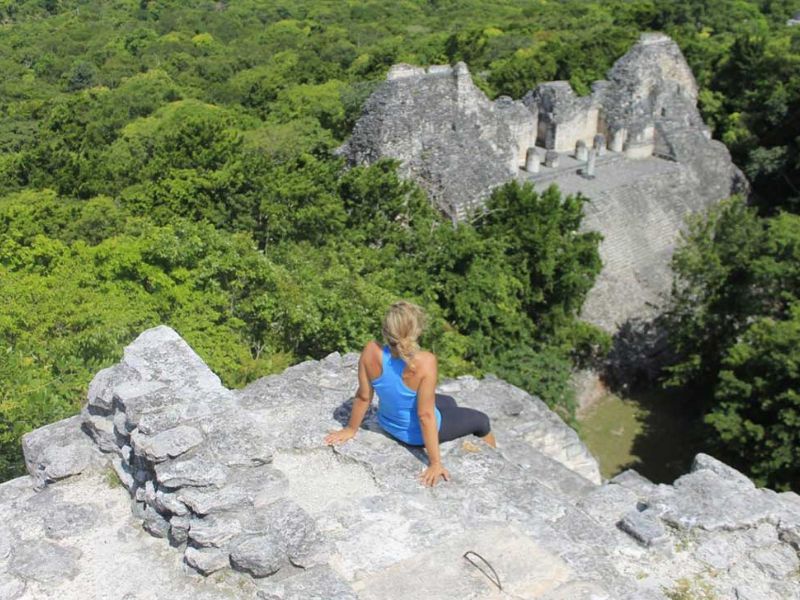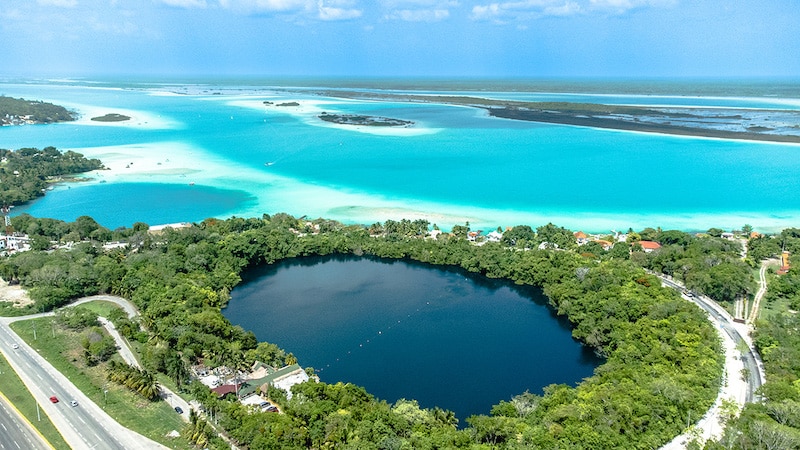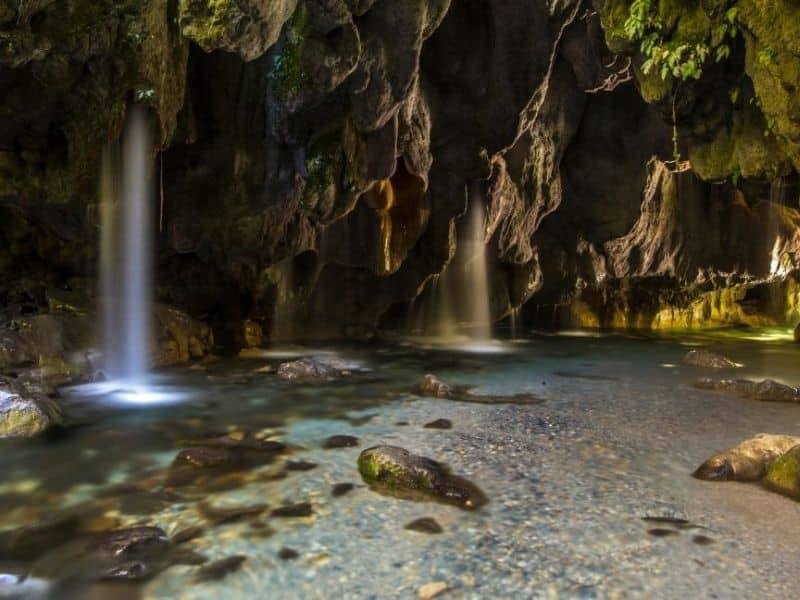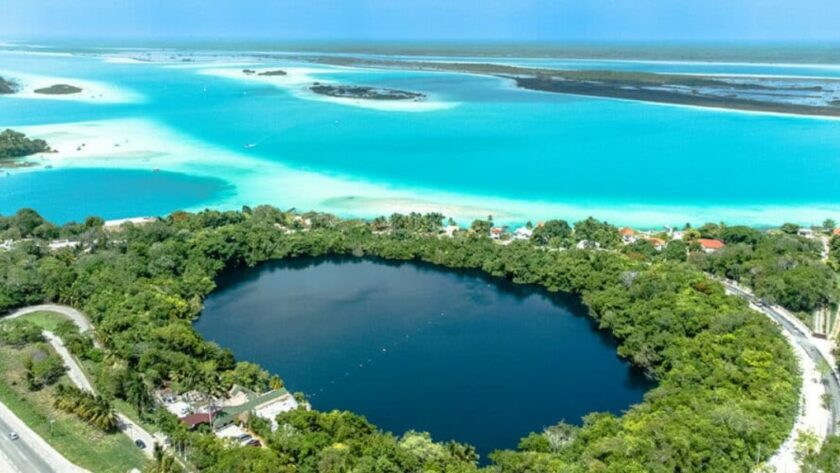By Isabella Biava. This article on sustainable tourism in Mexico contains affiliate links to trusted partners.
Looking for the best places for eco-tourism in Mexico?
Then you’re in the right place!
When planning a trip to Mexico, you have limitless booking options for tours, hotels, and other experiences. And while having choices can be a good thing, it’s important to realize that not all of these options are ethical.
That being said, there are tour operators and accommodations that go above and beyond to help preserve the country’s natural wonders and promote responsible tourism in Mexico.
To help you have a positive impact through your trip, we’re sharing five eco-friendly itineraries in Mexico.
Additionally, you’ll snag important tips for how you can travel sustainably in Mexico and help to protect the environment.
Defining Eco-Tourism In Mexico
But, first, what does “eco-friendly” actually mean?
While the definition varies slightly depending on who you ask, the Global Sustainable Tourism Council explains it as a niche segment of tourism in natural areas that particularly focuses on ethical, low-impact, locally-oriented trips.
It’s easy to confuse eco-friendly tourism with sustainable travel, as they’re similar; however, sustainability refers to “sustainable practices in and by the tourism industry, it is an aspiration for the impacts of all forms of tourism – all forms of tourism should be sustainable.”
So with that in mind, while we’re discussing how to plan an eco-friendly Mexico trip, the goal is really to be an all-around sustainable traveler — whether you’re visiting Mexico or somewhere else.
Remember, too, that small actions can have a huge impact, negative or positive. As travelers, let’s try to make our impact positive in the places we are so fortunate to get to visit.
On that note, let’s dive into our guide to green and responsible tourism in Mexico.
5 Best Places For Eco-Tourism In Mexico
Mexico currently has 40 UNESCO-designated biosphere reserves, which are defined as “learning places for sustainable development.”
This international label comes with a number of benefits, like access to funding resources for local conservation programs as well as education on the best eco-friendly practices for local authorities and the local population.
However, even with this label, there are still biosphere reserves where eco-friendly practices have sadly not been institutionalized by authorities, and so it is up to locals to step up and preserve the natural environment without the help of the law.
And while this guide to eco-tourism in Mexico focuses on some of the places where ecological practices are in place, we also aim to bring attention to areas that need help from locals and visitors to conserve the fragile environment.
On that note, let’s dive into our eco-friendly Mexico itineraries and tips.
1. Baja California Sur

In Baja California, there are four areas that are labeled as biosphere reserves, and two of them particularly stand out as tourist destinations:
- The Sierra de la Laguna, located in the south of the peninsula, which has a spectacular contrasting ecosystem made of woodlands and scrub, including a lot of endemic vegetation. There are great hikes that you can do in the Sierra de la Laguna that are organized with full respect for the environment.
- The Gulf of California, with its hundreds of islands, islets, and coastal areas — not to mention a wealth of underwater creatures for which the Sea of Cortez earned the nickname of the “Aquarium of the World.”
Not only can enjoy unforgettable hiking in Baja California, but amazing tours organized by eco-friendly companies (mentioned below) are available all around Baja in places like Loreto, La Paz, Todos Santos, and Cabo on the Pacific Coast.
The local tour agencies that operate in these reserves must follow certain ecological practices in order to preserve the environment, including:
✓ When visiting Espiritu Santo Island you are not allowed to swim with the sea lions from July through September in order to leave the creatures alone during their breeding season. You can only watch them from a 50-meter distance from the boat and go swimming in other nearby areas.
✓ Swimmers are encouraged not to use sunscreen before jumping in the water. Instead, you can use practical rash guards for sun protection.
✓ Whale shark swimming tours are limited to a certain number of visitors, and swimmers must jump in the water in turns to avoid disturbing the whales’ routine.
✓ The blue whale watching tours in Loreto keep a safe distance from the whales to avoid disturbing them in their natural environment. Local tour guides also take part in educational programs to learn best practices for protecting these graceful giants.
Eco-Friendly Baja California Sur Activities
► Hike in the Sierra de la Laguna with Baja Sierra Adventures, a company offering low-impact experiences to small groups of visitors while providing locals with a source of income.
► See humpback whales in Cabo Pulmo Marine Park with El Cardumen, a plastic-free tour company committed to conserving natural resources while providing a unique, fun, and safe experience for visitors.
► Swim with whale sharks in La Paz with La Paz Divers, a company founded by two biologists who are passionate about marine life and its preservation.
► Swim with the gray whales in San Carlos with Todos Santos Eco Adventures, whose entire adventure team is Leave No Trace certified.
► Take a blue whale watching tour in Loreto with Loreto Sea & Land Tours, a small family-owned operator dedicated to offering conscious, quality experiences.
► Dive in the marine life-rich Sea of Cortez with La Paz Divers (mentioned above).
Getting Around Baja California Sur
To get around Baja California Sur, having a car is recommended as public transportation is not reliable and doesn’t reach many of the most interesting spots. You can use a platform like Discover Cars to quickly and easily price compare your options.
The other possibility is joining local tours organized by eco-conscious travel companies, a few of which are mentioned above.
Best Eco-Friendly Hotels In Baja California Sur
White Lodge Baja (Los Cabos). This eco-luxury wellness retreat features an onsite spa as well as 10 private cottages built in total harmony with nature. It’s located 45 minutes from the Historic Center of San Jose del Cabo.
Hotel Baja Club (La Paz). This historic mansion turned hotel is now one of the most luxurious properties in La Paz. Its architect, Max von Werz, is a fervent advocate of sustainable architecture. In fact, his team rescued original timber beams and recovered as much of the original materials as possible to create this beautiful hotel. The property’s onsite Greek restaurant also serves sustainable seafood.
Camp Cecil de la Sierra (Todos Santos). This luxury tent camp offers glamping on a local ranch in the Sierra Laguna Mountains. Along with gorgeous views, guests can enjoy homemade food, opportunities for cultural immersion, and organized tours around the local reserve. Check out a 2-night itinerary they offer here.
Baja California Sur is also home to some of Mexico’s best vegan hotels, like Marquis Los Cabos and Esperanza, Auberge Resorts Collection.
2. Campeche

In the often underrated Mexican state of Campeche, you’ll find many incredible natural wonders, among which the spectacular Calakmul Biosphere Reserve particularly stands out. Visiting is one of the best things to do in Campeche.
Calakmul is the largest forest reserve in Mexico and, if you include the bordering countries of Guatemala and Belize, it becomes the second biggest forest in Latin America, after the Amazon.
Calakmul is also home to one of the most important and largest Maya ruins whose majestic temples peek out of the thick tropical jungle.
A visit to Calakmul requires some time and a car, which you can rent through Discover Cars, as there is much to explore inside the biosphere and in the surrounding areas.
The closest airports are in Chetumal as well as in Campeche, but you can also fly into Cancun or Merida and rent a car from there.
Honestly, Calakmul is a great addition to a Cancun itinerary, and if you have time you can plan a fantastic road trip on your way to the biosphere reserve and enjoy numerous cultural activities in the Yucatan Peninsula.
To explore Calakmul and its Maya ruins, you will need a full day — though if you also want to view wildlife, you’ll need to hire a local guide to take you inside the biosphere early at 6am. This is the best time to see the many bird species and other animals living there.
Note that only certified guides working for the Calakmul visitor center are authorized to enter this early with guests.
The visitor center is located in the small town of Xpujil and is a 45-minute drive from the Calakmul Biosphere Reserve. You should arrive a day early and book your guided tour for the following day.
That being said, if you have time, stay a couple of extra days in Xpujil to explore the local communities and their incredible artisan wares, from textiles to jewelry and home decor.
If you’re looking for authentic souvenirs from your eco-friendly trip to Mexico, consider purchasing these quality artisan goods, which also allows you to put money directly into the local economy.
The area is also full of fascinating archaeological sites hidden in the thick jungle as well as caves, pepper fields, and a lagoon.
Best Eco-Friendly Hotels In Calakmul
Chicanna Ecovillage Resort. Located on the road between Xpujil and Calakmul, this is a great option thanks to its convenient location and great value for money.
Hotel Puerta Calakmul. Located at the entrance of Calakmul, this resort is basic but very eco-friendly, and you will wake up surrounded by colorful birds — including toucans!
Rio Bec Dreams Hotel. This hotel has comfortable cabañas immersed in the tropical jungle at only a few minutes drive from Calakmul. The owners are also committed to eco-friendly practices, like collecting and using rainwater for the property as well as using greywater from the washing machine to flush the toilet.
3. Quintana Roo

Quintana Roo is probably the most visited state in Mexico. Because of this, it’s more likely to see a significant impact on its fragile environments.
There are many interesting natural wonders in Quintana Roo, including the Sian Ka’an Reserve and the spectacular cenotes.
That being said, in this eco-tourism in Mexico guide, we’re focusing on the beautiful Bacalar Lagoon — often called the “Maldives of Mexico.”
Bacalar Lagoon is a clear example of how conscious practices by local people can make an enormous positive impact on the environment where government institutions haven’t yet done the work.
UNESCO has not denoted Bacalar as a reserve; however, it very much needs to be protected as one if we want to keep enjoying its pristine blue waters.
In fact, it’s called the “Lagoon of Seven Colors” for its spectacular seven shades of blue, which is what makes it so special. Here, you can swim, kayak, paddleboard, and bird-watch. Additionally, nearby you can visit a cenote, Maya ruins, and more.
The local operators that handle the sailing boat tours and non-motorized water activities have created an association called Agua Clara to promote the preservation of the lagoon and its fragile ecosystem, including the delicate stromatolites — layered sedimentary formations known as the Earth’s oldest living lifeforms.
Agua Clara members are trying to capture the attention of the public to ultimately get the support of local authorities, but with little success, unfortunately.
If you ask them, there are political reasons and economic interests that keep Bacalar Lagoon from becoming a natural reserve.
And while it’s understandable that finding a balance between preserving the environment and making a living can be challenging, one can’t ignore that the increasing number of motorboats is a threat to the lagoon’s ecosystem.
On top of that, local authorities have recently given authorization for jet skis, which were prohibited before, to operate. And because it’s lucrative for business, jet ski operators have quickly multiplied, which is another obstacle in keeping the lagoon clean and healthy.
Since the government is not helping, it is up to locals and visitors to step up and do the right thing.
Here are a few ways you can help preserve Bacalar Lagoon:
- Do not book tours on motor boats or jet skis
- Join sailing, kayaking, and paddleboarding tours instead
- Do not walk on the stromatolites or touch them in any way
- Do not use sunscreen, even if it’s reef-safe, before getting in the water
- Do not take anything from the lake, like sand
- If visiting Isla de los Pajaros (Bird Island) to see birdlife like parrots, parakeets, and green jays, it’s recommended to kayak there and not get too close to the shoreline to avoid disturbing the birds
Best Eco-Friendly Hotels In Bacalar
Casa Lamat. This is a stylish eco-friendly hotel on the lagoon that has developed its own system for the correct use of water, trash, and electricity. They also promote non-motorized activities and use low-flow showerheads, low-flush toilets, and biodegradable soap, among other things.
MIA Bacalar. This high-end eco-friendly hotel in Bacalar keeps their energy to a minimum by using an intelligent system while their water is recycled and treated to irrigate the gardens. These are just a few of the many steps this property takes to operate sustainably.
4. Queretaro

Queretaro is one of the smallest states in Mexico and yet has some of the country’s most diverse ecosystems — such as the Sierra Gorda, a UNESCO Biosphere Reserve.
Much of the credit for this goes to a woman named Martha Isabel “Pati” Ruiz Corzo who, in 1987, co-founded GrupoEcologico Sierra Goxrda (GESG) with Roberto Pedraza Muñoz and local residents. Their goal: to get people caring about the biodiversity of the region.
To do this, she built alliances with other local organizations committed to the preservation of the reserve.
There are actually 10 reserves within the Sierra Gorda Biosphere dedicated to the preservation of local wildlife and forestation, as well as to fighting poverty and climate change, supporting biodiversity, and aiding the regeneration of natural infrastructure.
The best way to enjoy the Sierra Gorda is by spending a few days in Pinal de Amoles or Jalpan de Sierra and taking tours with local guides.
One recommended local guide is Bernardo Resendiz. He’s a certified bilingual guide based in Pinal De Amoles and organizes tours in Spanish and English in the Sierra Gorda. You can view his Facebook page and YouTube channel, or email him at [email protected].
Alternatively, you can stay in one of the local Sierra Gorda ecolodges and book your tours directly with them.
Eco-Friendly Sierra Gorda Activities
► Hike to El Chuveje Waterfall, which offers a spectacular trek along a river until you get to the beautiful waterfall surrounded by lush vegetation.
► Hike along the Cañón de la Angostura in Pinal de Amoles, a spectacular trail in a canyon that leads you to a natural pool with small waterfalls.
► Head to the Cuatro Palos lookout to admire spectacular views of the mountainous landscape from above the clouds.
► Check out some of the old missions (churches) — especially Bucareli, which is located in the middle of a deserted area surrounded by hills and canyons.
Eco-Friendly Hotels In The Sierra Gorda
Sierra Gorda Ecotours offers sustainable lodging around Jalpan de La Sierra, a Mexican Pueblo Magico, and you can also book eco-friendly tours with them to explore the amazing biodiversity of the Sierra Gorda.
5. The State of Mexico

In the State of Mexico, you can enjoy many unique experiences in nature — like witnessing up to 1 billion monarch butterflies do their annual migration from Canada and the USA to this area of Mexico.
The Monarch Butterfly Biosphere Reserve, a UNESCO World Heritage site that borders the State of Mexico and Michoacán, is one place to witness this natural phenomenon. This reserve aims to protect the butterfly species and its habitat, as it’s home to many important overwintering sites for the monarch.
From the lovely colonial town of Valle de Bravo, you can visit the reserve by car or taxi (which should cost around 200 MXN each way). You’ll need to get to Piedra Herrada, which is about a 40-minute drive.
Once you arrive, you can spend an entire day hiking the onsite trails and watching thousands of these beautiful butterflies flying around you. While there, it’s vital that you watch your step to avoid stepping on any.
Actually, it is required to have a local guide with you while visiting. Guides not only share important information about the local flora and fauna, but also help to ensure visitors follow best practices and avoid harming the butterflies.
Guides can be booked right at the entrance of the reserve, and will take you either on a short hike or on a horseback ride, depending on the kind of tour you want to take. The entrance fee is included in the tour.
Eco-Friendly Hotels In Valle de Bravo
Rancho El Reencuentro Eco-Hotel. This rustic chic hotel nestled in the countryside, just outside Valle de Bravo, offers stylish and spacious rooms as well as interesting activities like horseback riding, culinary workshops, and the opportunity to learn about their permaculture projects.
Hotel Rodavento. This luxury property in Valle de Bravo showcases 35 spectacular private suites scattered around the forest and overlooking a lake. Guests will enjoy relaxing by the pool, getting pampered with organic spa treatments, or doing onsite adventure activities like ziplining and climbing.
General Tips For Eco-Tourism In Mexico
Whether you’re aiming to plan an eco-friendly Mexico itinerary or a trip to another destination, here are a few best practices to keep in mind:
✓ Stay in a small locally-run hotel instead of an all-inclusive one.
✓ Use biodegradable mosquito sprays and sunscreens (when allowed).
✓ Do not use sunscreen or mosquito spray in Bacalar Lagoon, cenotes, and other places where it is not allowed (instead opt for rash guards).
✓ Respect local eco-friendly guidelines that are shared with you.
✓ Do not touch or damage the local flora and fauna, including coral reefs and stalactites and stalagmites in caves and cenotes.
✓ Avoid motorized watersports when possible.
✓ Do not support animal-related attractions that keep animals in captivity. A great example is swimming with the dolphins, which is an irresponsible wildlife tourism option that promotes animal cruelty. Instead, follow ethical wildlife tourism guidelines.
✓ Don’t buy souvenirs that include shells or parts of living organisms.
✓ If you find trash on the beach or in the water, take it with you. You can use this free trail cleanup game to gamify the cleanup, too.
✓ Follow Leave No Trace principles by respecting local wildlife, not taking any natural elements you find like shells or rocks, and taking your waste with you.
✓ Avoid bottled water as much as possible by using a reusable water bottle and asking for a refill where available.
✓ Eat in locally-run restaurants and shop local to put money directly back into the local economy.
✓ Choose tour operators with a clear commitment to the environment as well as local people and wildlife. Typically, conscious operators will have a page sharing how their experiences promote responsible tourism, though don’t be afraid to email or call them to ask your own questions, such as the ones listed in this guide to avoiding greenwashing.
Eco-Tourism In Mexico: Final Thoughts
Traveling responsibly in Mexico is possible not only in protected areas where eco-tourism is ingrained in local policy and culture, but everywhere we go.
As travelers, we have the opportunity — and obligation — to ensure our impact is positive in the destinations we visit.
This is especially important to keep in mind when visiting places that are not officially designated as protected, as eco-friendly guidelines aren’t as clearly spelled out. Instead, it is up to us to maintain awareness and help to create necessary change.
What would you add to this list of best places for ecotourism in Mexico?
Bonus Mexico Travel Resources:
Artisanal Tequila Distilleries In Mexico You Need To Visit
6 Authentic Cultural Activities In Mexico’s Yucatan Peninsula
Vegan & Vegetarian Food In Mexico: The Ultimate Guide
Exploring Mezcal & Mushrooms In The Land Of The Zapotec
About The Author
Isabella Biava is a relentless nomad who travels for the sake of traveling and photographing places. On her blog Boundlessroads.com she aims to inspire other women to travel solo, while on Letstraveltomexico.com she shares her knowledge of Mexico, where she has lived for the past 15 years.





I just want to say that I love your blog since I found it by chance. I always find interesting content here where I learn something new and inspiring. Thank you very much for that! Greetings from Canada
Like to travel, if go to Mexico, this article is a very good strategy, thanks for sharing
What beautiful places, I hope to visit them someday!
Simply excellent! I congratulate you for this wonderful publication. Best regards
Wonderful article!
thanks for the article
forbiddendfile.blogspot.com
This is the place to come for all the best advice and information on living an awesome life
What wonderful information, thank you!
I love vacationing in Mexico. My favorite place is Monterrey, because the countryside and scenery are very beautiful and there are many things to do in the city.
I have flown there with my friends several times already and we all like it very much. I advise you to rent a car on the rental24h.com website to make it easier to press, because the city itself is not small